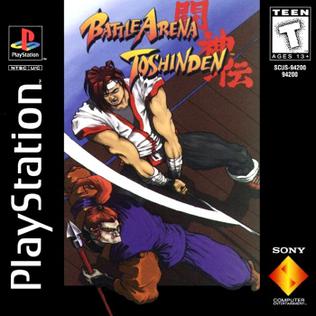
Battle Arena Toshinden is a fighting video game developed by Tamsoft and published by Takara for the PlayStation. Originally released in 1995, it was released internationally by Sony Computer Entertainment, followed by 1996 ports for the Sega Saturn, Game Boy and MS-DOS. It was one of the first fighting games, after Virtua Fighter in 1993 on arcade and console, to boast polygonal characters in a 3D environment, and features a sidestep maneuver which is credited for taking the genre into "true 3D."

Ogre Battle: The March of the Black Queen is a 1993 real-time tactical role-playing game developed by Quest Corporation. Originally published for Super NES by Quest in Japan and by Enix America in North America. It is the first installment of the Ogre Battle series. It was directed by Yasumi Matsuno, and designed by Matsuno with Akihiko Yoshida. The story of Ogre Battle focuses on a band of rebels as they lead a revolution against a corrupt reigning Empire, ruled by an evil Empress.

Ogre Battle is a series of five tactical role-playing and real-time strategy video games developed by Quest Corporation and is currently owned by Square Enix through Square's acquisition of Quest. There are five main games in the series, starting with the release of Ogre Battle: The March of the Black Queen in 1993.

Mega Man Battle Chip Challenge, known in Japan as Rockman EXE Battle Chip GP, is a video game developed by Inti Creates and published by Capcom for the Game Boy Advance (GBA) handheld game console. It is a spin-off title in the Mega Man Battle Network series. The game saw a simultaneous August 8, 2003 release in Japan on the WonderSwan Color and Swan Crystal titled Rockman EXE N1 Battle. The GBA version was localized in North America and Europe the following March. The European version featured a completely different logo, which was also used on Mega Man X7, Mega Man X8, Mega Man X: Command Mission, Mega Man Zero 2, Mega Man Zero 3, Mega Man Zero 4, Mega Man Network Transmission, Mega Man Battle Network 3, Mega Man Battle Network 4, and Mega Man Battle Network 5. It was released on the Wii U's Virtual Console on July 30, 2014 in Japan, with both the North American and PAL region release occurring in August 2014.
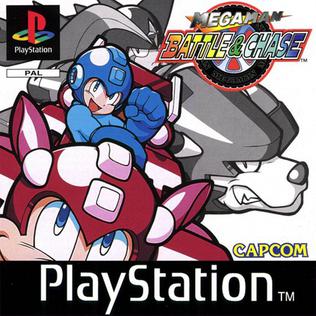
Mega Man: Battle & Chase is a racing video game based on the original Mega Man series from Capcom. The game was released in Japan on March 20, 1997 and in the PAL region on April 3, 1998 for PlayStation. Although it was not released individually in North America, Mega Man: Battle & Chase was featured on the region-exclusive Mega Man X Collection in 2006. Mega Man: Battle & Chase is a traditional racing game with an emphasis on combat. Winning a race allows the player to choose a car part from an enemy competitor as a prize. Reviews for the game have been mixed with many critics drawing comparisons to Nintendo's Mario Kart series.

Mega Man: The Power Battle is an arcade video game and a spin-off title for the Mega Man series. It was released in Japan in 1995 and was followed by a sequel, Mega Man 2: The Power Fighters, the following year. Both games—which were the first and only arcade titles ever to exist within the Mega Man franchise—were ported to home consoles in North America in 2004 as part of the Mega Man Anniversary Collection for PlayStation 2, GameCube, and Xbox and in Japan during the same year as part of two game compilation titled Rockman Power Battle Fighters, also for the PlayStation 2. An adaptation of both games for the Neo Geo Pocket Color, titled Rockman Battle & Fighters, was also made. Both games were later re-released as part of the Capcom Arcade 2nd Stadium compilation in 2022.

Sengoku Basara (戦国BASARA) is a series of video games developed and published by Capcom, and a bigger media franchise based on it, including three anime shows, an anime movie, a live action show, and numerous drama CDs, light novels, manga, and stage plays. Its story is loosely based on real events of the titular Sengoku period in the history of feudal Japan. Sengoku Basara was popular in Japan when the games released as they won multiple awards, became a cultural phenomenon, been cited as an example of games as art, and gained a passionate fanbase.

Street Fighter IV is a 2.5D fighting game published by Capcom, who also co-developed the game with Dimps. It was the first original main entry in the series since Street Fighter III in 1997, a hiatus of eleven years.
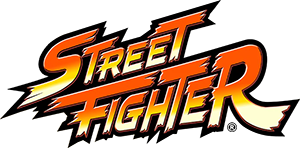
Street Fighter is a Japanese media franchise centered on a series of fighting games developed and published by Capcom. The first game in the series was released in 1987, followed by six other main series games, various spin-offs and crossovers, and numerous appearances in other media. Its best-selling 1991 release Street Fighter II established many of the conventions of the one-on-one fighting genre.
Dragon Ball Z Game Music is a series of soundtracks of various video games based on the popular anime series Dragon Ball Z for the Famicom, Super Famicom, PlayStation, and Saturn consoles. They were produced from 1993 to 1996. Most, with some exceptions, were distributed by Forte Music Entertainment, and were released in Japan only.
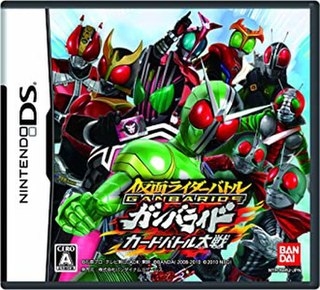
Kamen Rider Battle: Ganbaride is a combination of an arcade game and a collectible item game featuring the protagonists of the Kamen Rider Series. The game is being released as part of the 10th anniversary of the Heisei run Kamen Rider Series by Toei, TV Asahi & Ishimori Productions and features heavy tie-ins with the television series Kamen Rider Decade, whose protagonists use cards similar to those used in the game. It is played in a similar fashion to Sega's Mushiking and Dinosaur King games, and uses special Data Cardass cards released by Bandai. The game's card input uses collectible card game terminologies, and has resemblance and functionality similarly to the Decadriver in Decade. As the series progresses, the game controls change to suit the new Kamen Rider. During the airing of Kamen Rider OOO, Ganbaride arcade systems included an OOO Driver interface for the toy Core Medals, and with the broadcast of Kamen Rider Fourze, slots for the Astro Switches became available, and the system became 3 VS. 3. During the broadcast of Kamen Rider Wizard, Wizard Rings were available to use, and the game was reverted to 2 VS. 2 battles.

Super Street Fighter IV is a 2.5D fighting game produced by Capcom. It is an updated version of Street Fighter IV and has been said to mark the definitive end of the Street Fighter IV series. Having been deemed too large an update to be deployed as DLC, the game was made into a standalone title but given a lower price than that of a full retail game. It was released in April 2010 for the PlayStation 3 and Xbox 360. Super Street Fighter IV: 3D Edition was released as one of the launch titles for the Nintendo 3DS, with 3D functionality, on February 26, 2011, in Japan. The game has sold 1.9 million units worldwide, while the 3D Edition for the 3DS has sold an additional 1.1 million units worldwide.
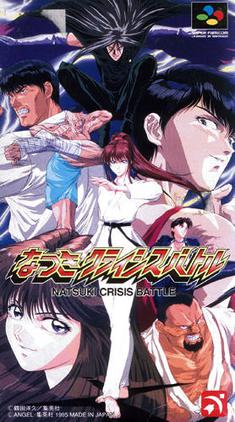
Natsuki Crisis Battle (なつきクライシスバトル) is a 1995 video game that was released exclusively for the Japanese Super Famicom. Based on the two-episode OVA and manga Natsuki Crisis, which was serialized in the magazine Business Jump, the player can choose from eight characters and fight on locations such as inside a budō gym, outside a high school and other locations.

Gensō Suikoden: Tsumugareshi Hyakunen no Toki "Gensō Suikoden: The Woven Web of a Century" is a role-playing video game developed by Konami for the PlayStation Portable. It was released in Japan on February 9, 2012.
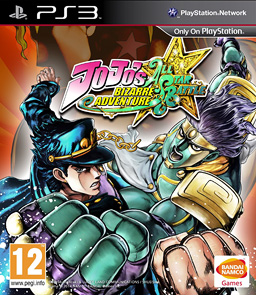
JoJo's Bizarre Adventure: All Star Battle is a fighting game developed by CyberConnect2 and published by Bandai Namco Entertainment for PlayStation 3. Based on Hirohiko Araki's long-running manga series JoJo' s Bizarre Adventure, the game allows players to compete against each other using 40 characters taken from the first eight story arcs, as well as one guest character from another manga also created by Araki. The game was released in Japan on August 29, 2013, and was released internationally in late April 2014.

The Japanese video game magazine Famitsu reviews video games by having four critics each assign the game a score from 0 to 10, with 10 being the highest score. The scores of are then added together for a maximum possible score of 40. As of 2024, thirty games have received perfect scores from Famitsu.

Dragon Ball Z: Super Butōden, known as Dragon Ball Z in Europe, is a 1993 fighting video game developed by Tose and published by Bandai for the Super Nintendo Entertainment System. It is based upon Akira Toriyama's Dragon Ball franchise, and was its first fighting game.

Gundam: Battle Assault 2 is a 2002 fighting video game developed by Natsume Co., Ltd. for the PlayStation. Based on the Gundam franchise, it is a follow-up to Gundam: Battle Assault (1998). The story is divided into three storylines following a pilot from Mobile Fighter G Gundam, Mobile Suit Gundam Wing and Mobile Suit Gundam. Its gameplay consists of one-on-one fights, with a main six-button configuration, featuring special moves and two playable modes, while players can select any available mech to battle against enemies in story mode.
















